Exceedingly Rare Dove Decoy, Chauncey Wheeler (1888-1945)
Lot 287
About Seller
Copley Fine Art Auctions
20 Winter Street
Pembroke, MA 02359
United States
Founded in 2005, Copley Fine Art Auctions is a boutique auction house specializing in antique decoys and American, sporting, and wildlife paintings. Over the course of the last two decades, the firm has set auction records for not only individual decoy makers, but also entire carving regions. Copley...Read more
Estimate:
$3,000 - $5,000
Absentee vs Live bid
Two ways to bid:
- Leave a max absentee bid and the platform will bid on your behalf up to your maximum bid during the live auction.
- Bid live during the auction and your bids will be submitted real-time to the auctioneer.
Bid Increments
| Price | Bid Increment |
|---|---|
| $0 | $50 |
| $1,000 | $100 |
| $2,500 | $250 |
| $5,000 | $500 |
| $10,000 | $1,000 |
| $25,000 | $2,500 |
| $50,000 | $5,000 |
About Auction
By Copley Fine Art Auctions
Jul 25, 2019
Set Reminder
2019-07-25 10:00:00
2019-07-25 10:00:00
America/New_York
Bidsquare
Bidsquare : The Sporting Sale 2019
https://www.bidsquare.com/auctions/copley/the-sporting-sale-2019-4227
July 25 at 10 am | 550 lots Copley Fine Art Auctions cinnie@copleyart.com
July 25 at 10 am | 550 lots Copley Fine Art Auctions cinnie@copleyart.com
- Lot Description
Chauncey Wheeler (1888-1945)
Alexandria Bay, NY, c. 1915
11 1/2 in. long
This hunting decoy belonged to washing machine magnate Lewis "Bud" Maytag (1926-1990) and came off his Sedgefield Plantation in Union Springs, Alabama.
"Bud" Maytag was featured in a 1966 "Sports illustrated" article "Shooting on Mr. Bud's Place."
Discussing Sedgefield Plantation author Virginia Kraft writes, "one of the last great sprawling plantations of the deep South is L. B. Maytag's Sedgefields, in Union Springs, Alabama, where the dainty bobwhite quail, not cotton, is king and where hunting is regally reminiscent of the antebellum years."
According to "Chance" author Harold W. Reiser III, “Along with making decoys for Abercrombie & Fitch, local residents, and himself, back in the early 1900s Wheeler was commissioned by his most famous customer and student, world-renowned bandmaster John Philip Sousa [1854-1932]. John asked Wheeler to carve him a flock of dove decoys for his hunting lodge in Sachets Harbor, New York. This rig of doves is the only rig of its kind that Chauncey ever made.”
It is plausible that Sousa, who was a hunter, may have gifted this decoy to Maytag on a Southern hunting trip. Excellent original paint with even wear, a hairline crack in neck crack, some flaking to metal tail, and restoration to bill.
Provenance: Louis B. Maytag Rig
Gifted by Maytag to his plantation manager
Private Collection by descent from the above
Private Collection, Florida
Literature: Harold W. Reiser III, "Chance, A Man of Great Talent, Strength and Mystery," Lewes, DE, 2002, p. 53, closely related example illustrated.
Hal Sorenson, "Decoy Collector’s Guide," 1966-1967, p. 35, related example illustrated.
Richard W. Oliver Auction Gallery, "Rare and Important American Bird Decoys," Kennebunk, ME, July 2-3, 1988, lot 268, related example illustrated.Please email condition report requests to colin@copleyart.com. Any condition statement given is a courtesy to customers, Copley will not be held responsible for any errors or omissions. The absence of a condition statement does not imply that the lot is in perfect condition.Condition
- Shipping Info
-
Shipping info
Copley Fine Art Auctions does not handle the shipping of any items. Shipping is the sole responsibility of the buyer. Once your payment has cleared, and we have received your authorized shipping release form items may be released for shipment. Copley Fine Art Auctions, LLC shall have no liability for any loss or damage to such items. Buyers should allow up to four weeks for shipment.Please be aware that internet bidders may NOT not pick up their items at the sale. Items will be available for pick up by appointment or by shippers five days after the sale.
-



 EUR
EUR CAD
CAD AUD
AUD GBP
GBP MXN
MXN HKD
HKD CNY
CNY MYR
MYR SEK
SEK SGD
SGD CHF
CHF THB
THB














